#NationalPoutineDayCanada
Explore tagged Tumblr posts
Photo

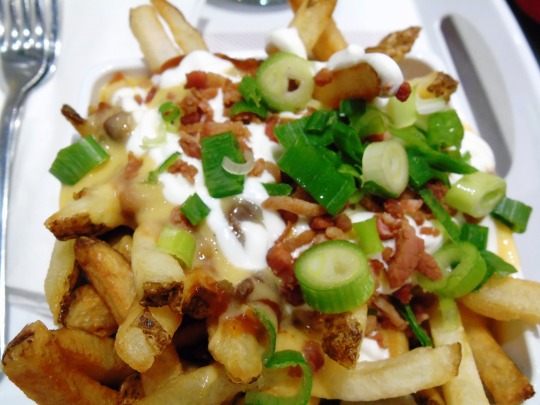
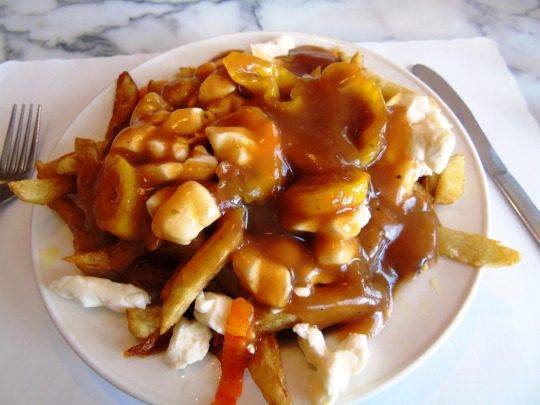
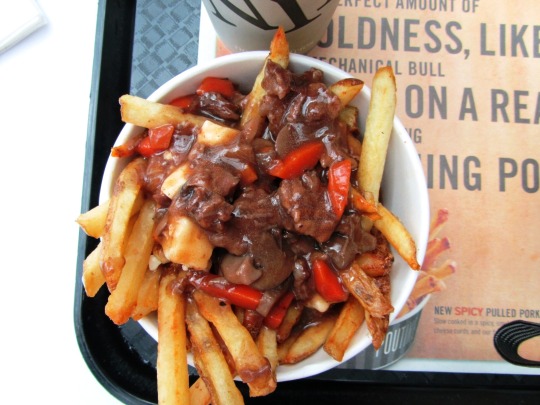
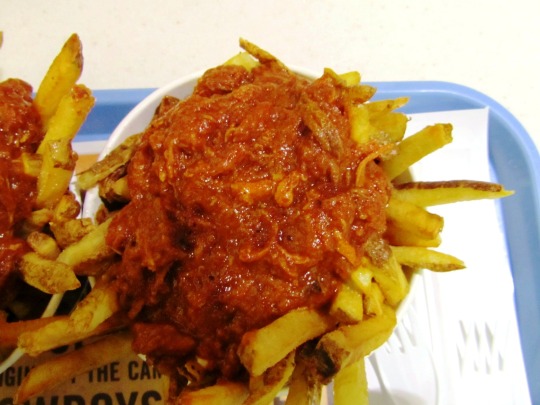
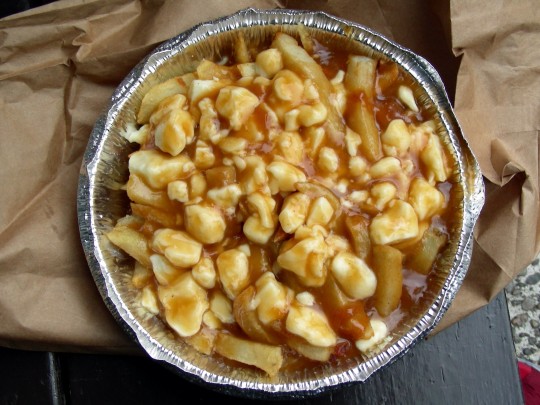
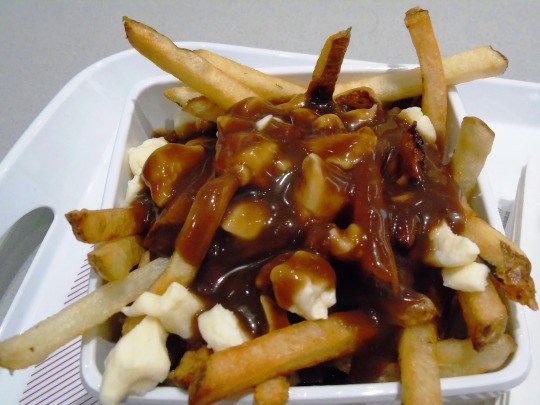
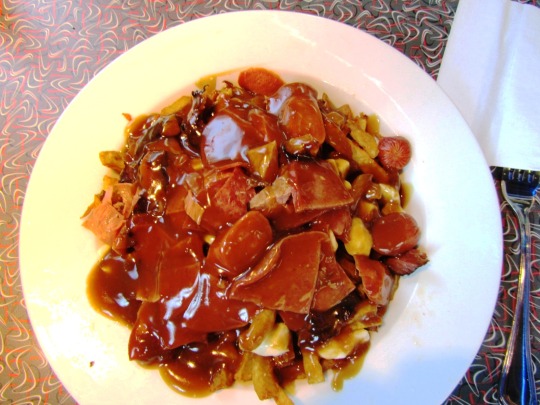

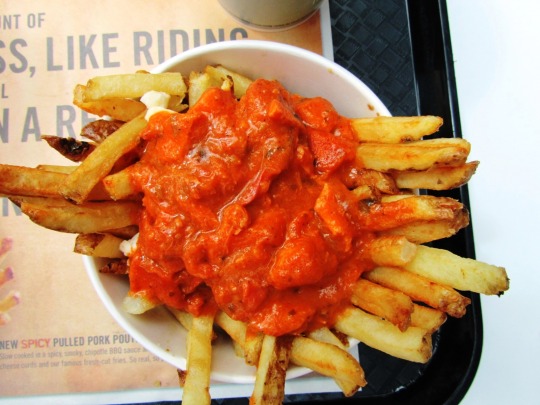
National Poutine Day
In Canada, particularly in Quebec, poutine is a staple food, if not also an iconic one. It has become a popular food in America as well as in other countries, and we celebrate it today, on National Poutine Day. Standard poutine is made up of fresh-cut french fries, squeaky fresh cheese curds, and brown gravy, but there are many variations of the dish. Among other possibilities, the name may have come from the word "pudding," which is spelled pouding in French, or from poutine, which is slang for "mess" in Quebec. It is pronounced "pou-tin" in the French-dominated regions of Quebec and New Brunswick, but as "poo-teen" elsewhere.
According to the most widely known and accepted story, poutine was first served at L’Idéal (Café Ideal)—a restaurant that later changed its name to Le Lutin Qui Rit (The Laughing Elf)—in 1957, in the small town of Warwick, in Arthabaska County, Quebec, a town known for producing squeaky cheese curds. A usual customer, Eddy Lainsesse, requested curds on top of his fries. The restaurant owner, Fernand Lachance, supposedly replied, "Ça va faire une maudite poutine," which roughly translates to "That's going to make a dreadful mess." A variation of the story says that Lainsesse asked for the curds and fries to be thrown together in a paper bag, upon which Lachance looked into the bag and said, "This is poutine." The dish started being sold in a bag and soon caught on. Patrons began adding ketchup and vinegar to it. In 1963, Lachance began serving it on plates. Customers soon noticed that the fries got cold quickly, so Lachance added gravy to keep them warm.
According to another story, poutine was created by Jean-Paul Roy, owner of Le Roy Jucep, a drive-in restaurant in Drummondville, Quebec. He had been serving a dish of gravy and french fries called patate-sauce since 1958, and in 1964 noticed that some of his diners were adding cheese curds to it. He soon added a dish that contained all three ingredients and named it fromage-patate-sauce.
No matter how poutine got its start, it soon could be found being sold as street food in Canada. By 1969 it was being sold in Quebec City at the Ashton Snack Bar food truck on Boulevard Wilfred-Hamel, and it was being sold in Montreal by 1983. By the early 1980s, it had become a widely popular street food in Ontario and Quebec.
It made its debut in Canadian chain restaurants in 1985, appearing on the menu at Frits, a now-defunct Quebec-based chain. By the 1990s, poutine had reached mass popularization in the country, after its inclusion on the menus of other chains. It first appeared on a Burger King menu in 1987 in Quebec, and soon spread to other locations of the chain. The same happened with McDonald's in 1990. Canadian fast-food chain Harvey's debuted it on menus across the country in 1992.
But poutine wasn't to remain only as street food and fast food. By the early 2000s, it was appearing in high-end Canadian restaurants. It was put on the menu at Aud Pied de Cochon in Montreal in 2002, where it was topped with foie gras. Other high-end Montreal restaurants followed suit. Garde Manger began serving an Iron Chef America-winning lobster poutine, and Pub Quartier Latin put poutine made with steak, truffles, and red wine demi-glace on their menu.
Some Canadian restaurants have made poutine their main focus. La Banquise in Montreal began serving it in the 1980s. They started with the standard version and an Italian version with bolognese sauce instead of gravy. They have since expanded to serving 30 types. Smoke's Poutinerie was started in Toronto in 2008, the first poutine-only restaurant in that city. Other poutine-only restaurants that followed in Canada are Poutini's House of Poutine, La Poutinerie, and Poutineville.
Poutine made its first foray into the United States in New Jersey and New York, where a variation of the recipe called "Disco Fries" became popular. This version substituted mozzarella or cheddar cheese for the curds. Poutine has since become relatively common in the States, and took hold in other countries as well, such as the United Kingdom and Russia.
As mentioned, there are various types of poutine besides the usual french fries, cheese curds, and gravy combination. Different types of potatoes, cheese, and sauces can be used. Italian poutine may use spaghetti sauce instead of gravy; veggie poutine is made with mushroom sauce and vegetables; Irish poutine is made with lardons. La galvaude is from Gaspésie and is made with chicken and green peas. A variation in Montreal uses smoked meat.
Festivals devoted to poutine are held across Canada throughout the year. Montreal, Ottawa, and Toronto are some cities that hold them. On National Poutine Day, events are held and specials are available at restaurants in countries like Canada and the United States. For example, My Meatball Place in Toronto has given away free samples of meatball and vegan poutine, and The Hops Spot in Syracuse has offered half-price poutine. With so many types of poutine—and so many restaurants that serve it in some parts of the world—there is no reason to remain hungry on National Poutine Day.
How to Observe National Poutine Day (Canada)
Here are some ideas on how to celebrate the day:
Make your own poutine. You could make the original version or another variation of the dish. You could even make Disco Fries, the Americanized version of the dish.
Check if there is a place near you that serves poutine.
Enjoy poutine at a Canadian restaurant that specializes in the dish, such as La Banquise, Smoke's Poutinerie, Poutini's House of Poutine, La Poutinerie, or Poutineville. Smoke's Poutinerie also has some locations in the United States.
Have poutine at a restaurant in Warwick, Quebec, the town where the dish is said to have originated, or have it at Le Roy Jucep in Drummondville, Quebec, the other location where it is said to have gotten its start.
Eat some poutine at Harvey's or at another fast food restaurant in Canada.
Enjoy poutine at a high-end Canadian restaurant such as Aud Pied de Cochon, Garde Manger, or Pub Quartier Latin.
See if there are any specials on poutine today at restaurants such as My Meatball Place in Toronto or The Hops Spot in Syracuse.
Plan a trip to an upcoming poutine fest, such as Montreal's Le Grand Poutinefest, Ottawa Poutine Fest, or Toronto Poutine Fest.
Source
#Poutine 911#Le Roy Jucep#the original one#Drummondville#Québec#travel#summer 2015#food#fries#cheese curd#gravy#restaurant#Poutine the Works#Bacon Double Cheese Poutine#Pulled Pork Poutine#Butter Chicken Poutine#Meat Lovers Poutine#National Poutine Day#Canada#NationalPoutineDayCanada#11 April#street food#vacation#2018#2012#Montréal
94 notes
·
View notes
Photo
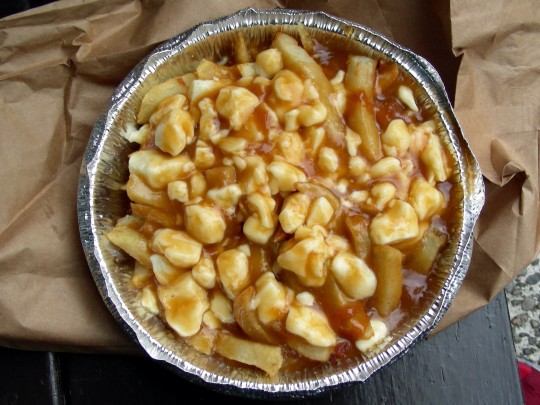
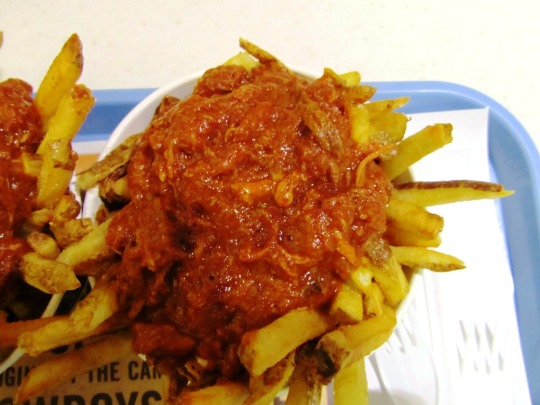

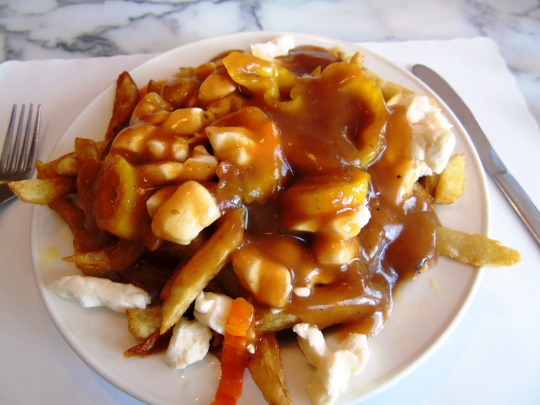
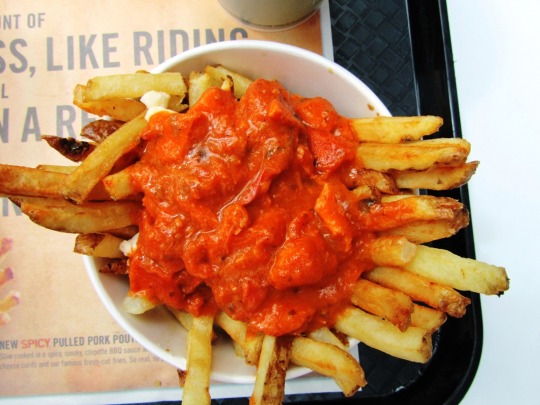

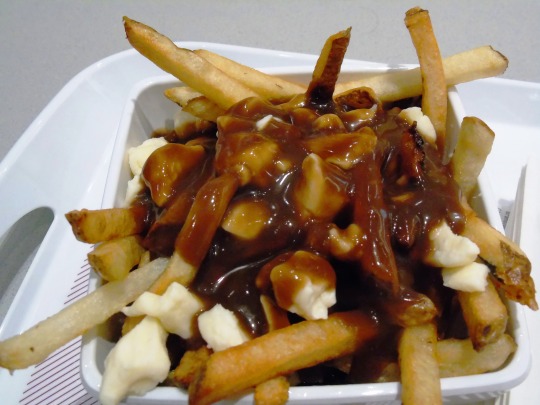
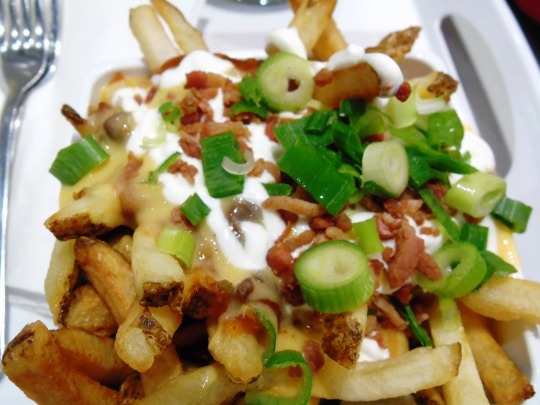
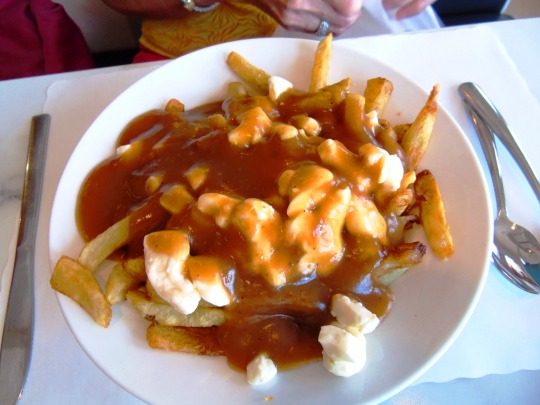

National Poutine Day
In Canada, particularly in Quebec, poutine is a staple food, if not also an iconic one. It has become a popular food in America as well as in other countries, and we celebrate it today, on National Poutine Day. Standard poutine is made up of fresh-cut french fries, squeaky fresh cheese curds, and brown gravy, but there are many variations of the dish. Among other possibilities, the name may have come from the word "pudding," which is spelled pouding in French, or from poutine, which is slang for "mess" in Quebec. It is pronounced "pou-tin" in the French-dominated regions of Quebec and New Brunswick, but as "poo-teen" elsewhere.
According to the most widely known and accepted story, poutine was first served at L'Idéal (Café Ideal)—a restaurant that later changed its name to Le Lutin Qui Rit (The Laughing Elf)—in 1957, in the small town of Warwick, in Arthabaska County, Quebec, a town known for producing squeaky cheese curds. A usual customer, Eddy Lainsesse, requested curds on top of his fries. The restaurant owner, Fernand Lachance, supposedly replied, "Ça va faire une maudite poutine," which roughly translates to "That's going to make a dreadful mess." A variation of the story says that Lainsesse asked for the curds and fries to be thrown together in a paper bag, upon which Lachance looked into the bag and said, "This is poutine." The dish started being sold in a bag and soon caught on. Patrons began adding ketchup and vinegar to it. In 1963, Lachance began serving it on plates. Customers soon noticed that the fries got cold quickly, so Lachance added gravy to keep them warm.
According to another story, poutine was created by Jean-Paul Roy, owner of Le Roy Jucep, a drive-in restaurant in Drummondville, Quebec. He had been serving a dish of gravy and french fries called patate-sauce since 1958, and in 1964 noticed that some of his diners were adding cheese curds to it. He soon added a dish that contained all three ingredients and named it fromage-patate-sauce.
No matter how poutine got its start, it soon could be found being sold as street food in Canada. By 1969 it was being sold in Quebec City at the Ashton Snack Bar food truck on Boulevard Wilfred-Hamel, and it was being sold in Montreal by 1983. By the early 1980s, it had become a widely popular street food in Ontario and Quebec.
It made its debut in Canadian chain restaurants in 1985, appearing on the menu at Frits, a now-defunct Quebec-based chain. By the 1990s, poutine had reached mass popularization in the country, after its inclusion on the menus of other chains. It first appeared on a Burger King menu in 1987 in Quebec, and soon spread to other locations of the chain. The same happened with McDonald's in 1990. Canadian fast-food chain Harvey's debuted it on menus across the country in 1992.
But poutine wasn't to remain only as street food and fast food. By the early 2000s, it was appearing in high-end Canadian restaurants. It was put on the menu at Aud Pied de Cochon in Montreal in 2002, where it was topped with foie gras. Other high-end Montreal restaurants followed suit. Garde Manger began serving an Iron Chef America-winning lobster poutine, and Pub Quartier Latin put poutine made with steak, truffles, and red wine demi-glace on their menu.
Some Canadian restaurants have made poutine their main focus. La Banquise in Montreal began serving it in the 1980s. They started with the standard version and an Italian version with bolognese sauce instead of gravy. They have since expanded to serving 30 types. Smoke's Poutinerie was started in Toronto in 2008, the first poutine-only restaurant in that city. Other poutine-only restaurants that followed in Canada are Poutini's House of Poutine, La Poutinerie, and Poutineville.
Poutine made its first foray into the United States in New Jersey and New York, where a variation of the recipe called "Disco Fries" became popular. This version substituted mozzarella or cheddar cheese for the curds. Poutine has since become relatively common in the States, and took hold in other countries as well, such as the United Kingdom and Russia.
As mentioned, there are various types of poutine besides the usual french fries, cheese curds, and gravy combination. Different types of potatoes, cheese, and sauces can be used. Italian poutine may use spaghetti sauce instead of gravy; veggie poutine is made with mushroom sauce and vegetables; Irish poutine is made with lardons. La galvaude is from Gaspésie and is made with chicken and green peas. A variation in Montreal uses smoked meat.
Festivals devoted to poutine are held across Canada throughout the year. Montreal, Ottawa, and Toronto are some cities that hold them. On National Poutine Day, events are held and specials are available at restaurants in countries like Canada and the United States. For example, My Meatball Place in Toronto has given away free samples of meatball and vegan poutine, and The Hops Spot in Syracuse has offered half-price poutine. With so many types of poutine—and so many restaurants that serve it in some parts of the world—there is no reason to remain hungry on National Poutine Day.)
Make your own poutine. You could make the original version or another variation of the dish. You could even make Disco Fries, the Americanized version of the dish.
Check if there is a place near you that serves poutine.
Enjoy poutine at a Canadian restaurant that specializes in the dish, such as La Banquise, Smoke's Poutinerie, Poutini's House of Poutine, La Poutinerie, or Poutineville. Smoke's Poutinerie also has some locations in the United States.
Have poutine at a restaurant in Warwick, Quebec, the town where the dish is said to have originated, or have it at Le Roy Jucep in Drummondville, Quebec, the other location where it is said to have gotten its start.
Eat some poutine at Harvey's or at another fast food restaurant in Canada.
Enjoy poutine at a high-end Canadian restaurant such as Aud Pied de Cochon, Garde Manger, or Pub Quartier Latin.
See if there are any specials on poutine today at restaurants such as My Meatball Place in Toronto or The Hops Spot in Syracuse.
Plan a trip to an upcoming poutine fest, such as Montreal's Le Grand Poutinefest, Ottawa Poutine Fest, or Toronto Poutine Fest.
Source
#Pulled Pork Poutine#National Poutine Day#NationalPoutineDayCanada#travel#11 April#Bacon Double Cheese Poutine#New York Fries#street food#Canada#restaurant#Poutine The Works#Le Roy Jucep#Poutine 911#Québec#Ottawa#Calgary#Ontario#Alberta#Spicy Pulled Poutine#Butter Chicken Poutine#original photography#Meat Lovers Poutince#BC#Vancouver#Pulled Beef Poutine#British Columbia#Montréal#cheese#gravy#French Fries
7 notes
·
View notes
Photo










National Poutine Day
In Canada, particularly in Quebec, poutine is a staple food, if not also an iconic one. It has become a popular food in America as well as in other countries, and we celebrate it today, on National Poutine Day. Standard poutine is made up of fresh-cut french fries, squeaky fresh cheese curds, and brown gravy, but there are many variations of the dish. Among other possibilities, the name may have come from the word "pudding," which is spelled pouding in French, or from poutine, which is slang for "mess" in Quebec. It is pronounced "pou-tin" in the French-dominated regions of Quebec and New Brunswick, but as "poo-teen" elsewhere.
According to the most widely known and accepted story, poutine was first served at L’Idéal (Café Ideal)—a restaurant that later changed its name to Le Lutin Qui Rit (The Laughing Elf)—in 1957, in the small town of Warwick, in Arthabaska County, Quebec, a town known for producing squeaky cheese curds. A usual customer, Eddy Lainsesse, requested curds on top of his fries. The restaurant owner, Fernand Lachance, supposedly replied, "Ça va faire une maudite poutine," which roughly translates to "That's going to make a dreadful mess." A variation of the story says that Lainsesse asked for the curds and fries to be thrown together in a paper bag, upon which Lachance looked into the bag and said, "This is poutine." The dish started being sold in a bag and soon caught on. Patrons began adding ketchup and vinegar to it. In 1963, Lachance began serving it on plates. Customers soon noticed that the fries got cold quickly, so Lachance added gravy to keep them warm.
According to another story, poutine was created by Jean-Paul Roy, owner of Le Roy Jucep, a drive-in restaurant in Drummondville, Quebec. He had been serving a dish of gravy and french fries called patate-sauce since 1958, and in 1964 noticed that some of his diners were adding cheese curds to it. He soon added a dish that contained all three ingredients and named it fromage-patate-sauce.
No matter how poutine got its start, it soon could be found being sold as street food in Canada. By 1969 it was being sold in Quebec City at the Ashton Snack Bar food truck on Boulevard Wilfred-Hamel, and it was being sold in Montreal by 1983. By the early 1980s, it had become a widely popular street food in Ontario and Quebec.
It made its debut in Canadian chain restaurants in 1985, appearing on the menu at Frits, a now-defunct Quebec-based chain. By the 1990s, poutine had reached mass popularization in the country, after its inclusion on the menus of other chains. It first appeared on a Burger King menu in 1987 in Quebec, and soon spread to other locations of the chain. The same happened with McDonald's in 1990. Canadian fast-food chain Harvey's debuted it on menus across the country in 1992.
But poutine wasn't to remain only as street food and fast food. By the early 2000s, it was appearing in high-end Canadian restaurants. It was put on the menu at Aud Pied de Cochon in Montreal in 2002, where it was topped with foie gras. Other high-end Montreal restaurants followed suit. Garde Manger began serving an Iron Chef America-winning lobster poutine, and Pub Quartier Latin put poutine made with steak, truffles, and red wine demi-glace on their menu.
Some Canadian restaurants have made poutine their main focus. La Banquise in Montreal began serving it in the 1980s. They started with the standard version and an Italian version with bolognese sauce instead of gravy. They have since expanded to serving 30 types. Smoke's Poutinerie was started in Toronto in 2008, the first poutine-only restaurant in that city. Other poutine-only restaurants that followed in Canada are Poutini's House of Poutine, La Poutinerie, and Poutineville.
Poutine made its first foray into the United States in New Jersey and New York, where a variation of the recipe called "Disco Fries" became popular. This version substituted mozzarella or cheddar cheese for the curds. Poutine has since become relatively common in the States, and took hold in other countries as well, such as the United Kingdom and Russia.
As mentioned, there are various types of poutine besides the usual french fries, cheese curds, and gravy combination. Different types of potatoes, cheese, and sauces can be used. Italian poutine may use spaghetti sauce instead of gravy; veggie poutine is made with mushroom sauce and vegetables; Irish poutine is made with lardons. La galvaude is from Gaspésie and is made with chicken and green peas. A variation in Montreal uses smoked meat.
Festivals devoted to poutine are held across Canada throughout the year. Montreal, Ottawa, and Toronto are some cities that hold them. On National Poutine Day, events are held and specials are available at restaurants in countries like Canada and the United States. For example, My Meatball Place in Toronto has given away free samples of meatball and vegan poutine, and The Hops Spot in Syracuse has offered half-price poutine. With so many types of poutine—and so many restaurants that serve it in some parts of the world—there is no reason to remain hungry on National Poutine Day.
Source
#Pulled Pork Poutine#Poutine#Bacon Double Cheese Poutine#street food#Canada#11 April#Montréal#Québec#Ottawa#Ontario#travel#vacation#original photography#NationalPoutineDayCanada#National Poutine Day#PoutineDayCanada#NationalPoutineDay#Poutine 911#Poutine the Works#Meat Lovers Poutine#Vancouver#Le Roy Jucep#Drummondsville#Butter Chicken Poutine#Calgary#summer 2015#2012#2009#2018#Jean-Paul Roy
7 notes
·
View notes